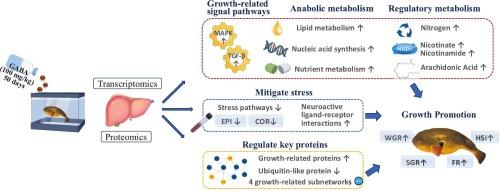饲料中γ-氨基丁酸(GABA)促进黄褐色河豚生长机制的转录组学和蛋白质组学研究
IF 2.2
2区 生物学
Q4 BIOCHEMISTRY & MOLECULAR BIOLOGY
Comparative Biochemistry and Physiology D-Genomics & Proteomics
Pub Date : 2025-08-09
DOI:10.1016/j.cbd.2025.101603
引用次数: 0
摘要
γ-氨基丁酸(GABA)已被证明能促进某些水生物种的生长,但其分子机制尚不清楚。通过生长性能、肝脏转录组学和蛋白质组学分析以及血浆应激指标,研究了GABA对黄褐色河豚幼鱼的影响。饲粮中添加100 mg/kg GABA 50 d可显著提高鱼的增重率(WGR)和特定生长率(SGR),提高采食率(FR)和肝体指数(HSI)。转录组学分析发现,DEGs主要富集于生长相关信号通路(MAPK、TGF-β)和合成代谢过程:脂质代谢(脂肪酸延伸、脂肪酰基辅酶a和脂肪酸衍生物的生物合成)、核酸合成(核苷酸、嘌呤)和营养代谢(维生素B6、色氨酸)。蛋白质组学分析显示,DEPs主要富集于调控过程:氮代谢、烟酸/烟酰胺代谢和花生四烯酸代谢。两个组学数据集都证实了GABA的应激缓解作用——应激途径(皮质醇合成、催产素信号传导、库欣综合征)的转录组下调和神经活性配体-受体相互作用的蛋白质组富集,GABA组较低的血浆应激指数证实了这一点。PPI分析显示,GABA通过激活生长相关蛋白[如Actin, α骨骼肌A (ACTA1B)],抑制泛素样蛋白7B (UBL7B),协调四个生长发育功能子网络来促进黄体菌的生长。综上所述,GABA通过激活生长相关信号通路和合成代谢/调节代谢,减轻应激,调节生长相关蛋白和泛素样蛋白,促进黄曲霉的生长。本研究首次通过综合方法揭示了GABA在黄曲霉中肝脏介导的促生长机制,为开发GABA作为功能性饲料添加剂提供了基础。本文章由计算机程序翻译,如有差异,请以英文原文为准。

Transcriptomic and proteomic insights into the growth-promoting mechanisms of dietary γ-aminobutyric acid (GABA) in tawny puffer (Takifugu flavidus)
γ-aminobutyric acid (GABA) has been shown to promote growth in certain aquatic species, yet the molecular mechanisms remain unclear. This study investigated the effects of GABA in juvenile tawny puffer (Takifugu flavidus) via growth performance, liver transcriptomic and proteomic analyses, and plasma stress indices. Dietary supplementation with 100 mg/kg GABA for 50 days significantly improved weight gain rate (WGR) and specific growth rate (SGR), alongside higher feeding rate (FR) and hepatosomatic index (HSI). Transcriptomic profiling identified DEGs predominantly enriched in growth-related signal pathways (MAPK, TGF-β), and anabolic processes: lipid metabolism (fatty acid elongation, fatty-acyl-CoA and fatty acid derivative biosynthetic), nucleic acid synthesis (nucleotide, purine), and nutrient metabolism (vitamin B6, tryptophan). Proteomic analysis revealed DEPs primarily enriched in regulatory processes: nitrogen metabolism, nicotinate/nicotinamide metabolism, and arachidonic acid metabolism. Both omics datasets confirmed GABA's stress mitigation—transcriptomic downregulation of stress pathways (cortisol synthesis, oxytocin signaling, Cushing syndrome) and proteomic enrichment of neuroactive ligand-receptor interactions, validated by lower plasma stress indices in the GABA group. PPI analysis revealed that GABA promotes growth in T. flavidus by activating growth-related proteins [e.g., Actin, alpha skeletal muscle A (ACTA1B)], inhibiting ubiquitin-like protein 7B (UBL7B), and coordinating four growth and development functional subnetworks. In conclusion, GABA promotes the growth of T. flavidus by activating growth-related signal pathways and anabolic/regulatory metabolism, mitigating stress, and regulating growth-related and ubiquitin-like proteins. This is the first study to unravel GABA's liver-mediated growth-promoting mechanisms in T. flavidus via comprehensive approaches, providing a basis for developing GABA as a functional feed additive.
求助全文
通过发布文献求助,成功后即可免费获取论文全文。
去求助
来源期刊
CiteScore
5.10
自引率
3.30%
发文量
69
审稿时长
33 days
期刊介绍:
Comparative Biochemistry & Physiology (CBP) publishes papers in comparative, environmental and evolutionary physiology.
Part D: Genomics and Proteomics (CBPD), focuses on “omics” approaches to physiology, including comparative and functional genomics, metagenomics, transcriptomics, proteomics, metabolomics, and lipidomics. Most studies employ “omics” and/or system biology to test specific hypotheses about molecular and biochemical mechanisms underlying physiological responses to the environment. We encourage papers that address fundamental questions in comparative physiology and biochemistry rather than studies with a focus that is purely technical, methodological or descriptive in nature.

 求助内容:
求助内容: 应助结果提醒方式:
应助结果提醒方式:


